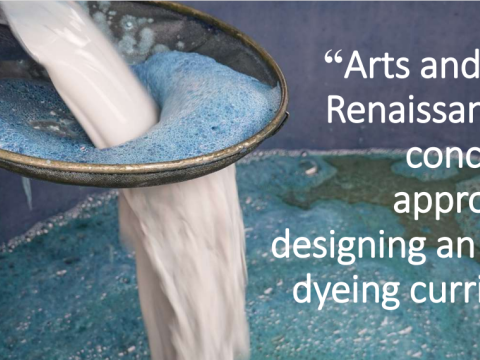“Arts and Crafts Renaissance” as conceptual approach in designing an indigo dyeing curriculum
“Arts and Crafts Renaissance” as conceptual approach in designing an indigo dyeing curriculum
Since the industrial revolution, craft revival movements have persistently stirred at the margins of art history. A long-held and prevalent misperception pits the decline of craft against the industrial revolution, wrongly positing craft and technology in binary opposition. How does firing clay turn it into pottery? How are metallic minerals smelted to become bronze? How does silica sand become glass? How do natural fibers become sanding threads? How are PET bottles and coffee grounds recycled into functional textiles? Traditional looms used by indigenous tribes exemplify the integration of humans and machines. Craft innovations are also innovations of medium, and represents an aspect of the industrial revolution; from the perspective of the history of human civilization, the history of craft is also the history of technology.
The “still-lingering definitions of craft as ‘technical knowledge’ and art as ‘aesthetic’ or ‘conceptual knowledge,’” as mentioned by Maria Elena Buszek (b. 1971) in Extra/Ordinary-Craft and Contemporary Art, explains ongoing scholarly debates on the bifurcated development of craft and fine arts. In the post-conceptual art era, the privileging of concept has made texts and various text-related arenas an integral to the language of visual art. However, advocating dematerialization through conceptual art has inadvertently neglected the traditional language of expression through material media. Interdisciplinary expression may be a prevailing trend, but the use of text and language as an artistic medium is not exclusive to conceptual art; literature itself is an artistic form that has an exhaustive history of using text as medium. On the other hand, bolstered by conceptual art, the philosophy of art has pivoted from the location of objective research into a position of dominant discourse. New propositions for a strategic “Arts and Crafts Renaissance” are necessary here because, in the era of post-conceptual art, craft will not only restore control over a diverse languages media for fine art or for visual art, but will also provide an alternate practical methodology that emphasizes a collaborative effort involving the corporeal, the medium, and the ideation within the framework of “concept + language media + artwork,” because art making is a type of practical knowledge.
When a language vanishes, the wisdom of a culture vanishes with it, regardless of which nation or tribe this culture belongs to. Craft is a language that embodies culture and civilization. When a craft becomes obsolete, the associated technology and cultural wisdom are lost along with it. Craft provides a technical solution for visual art, as well as aggregates the wisdom of a civilization. Visual art must acknowledge this asset and actively claim it as heritage. Creative resources for artists can be found from traditional craft to new technological media. The significance of this renewed proposal for “Crafts Renaissance” at this juncture calls for restoring the diverse media languages of art through an “Arts and Crafts Renaissance”, and the study of variations in expression and communication methods between different media languages.
Abstract expressionism has established a theoretical foundation for “media language” within the history of art. Exploring the nature of the language of painting includes issues of expressions through material and immaterial creative media in works of art. In terms of artistic creation, whether the “medium” old or new is irrelevant; the issues are in difference, expressivity, and diversity.
The above explains the conceptual background for establishing the “Indigo Dye in Artistic Practice” curriculum. Another facet of the curriculum design has been informed by opportunities to witness firsthand the potential for craft media to play active roles in contemporary art education, specifically in the practical coursework provided by seminars and workshops offered since 2011 in collaboration with the TNUA Center for Traditional Arts on the invitation of then-director Chen Wan-Lee. These include “Closely Weaving and Embroidering to Convey Sentiment – workshop on traditional weaving and embroidery,” “Fiber Craft: making tree bark cloth and a visit to the Bunun Kamcing Tribal Settlement,” “Traditional Grass Weaving Art,” “Fiber Craft: Tree Bark cloth art of the Bunon Tribe.”
The curriculum for Indigo Dye in Artistic Practice has been designed to comprise of four components: workshops, lectures, creative practice, and exhibition. From harvesting raw materials to producing indigo dye, from building a vat to various foundational skills offered through fieldwork and practice in the workshop component establishes basic foundations for indigo dyeing. For the lectures, instructors Tang Wen-Chun, Liu Chun-Ching, and Umezaki Yukiko; as well as Chiang Min-Chin, was the chairman of the TNUA Graduate Institute of Architecture and Cultural Heritage with extensive expertise in the research of craft -- were invited to provide a broad panorama for the indigo dye coursework that encompass a depth of history, and a breadth of background knowledge on global regional relationships. For the creative practice in the third component, I have organized a number of creative case studies from contemporary art and textile art to inspire students to imagine and advance possibilities for creative indigo work, while also providing suggestions or methods for production or creation through individual creative guidance. Students were urged in the final exhibition module to contemplate indigo dye as a holistic medium in relation to creative expression.
Craft and art making share a common foundation in their process of media treatment and in their treatment of issues or themes; that is, to transform ordinary materials or quotidian themes into extraordinary events or objects. Indigo stands apart as a case study among the plethora of craft subjects; the craft spans cultural regions and histories, and gathers the wisdom of human civilizations. We’re going to publish a book about our curriculum, the purpose of this book is not only to present the results of the indigo curriculum, but is also in the hope that the concept of an “Arts and Crafts Renaissance” may inject a new creative vitality into contemporary art.
